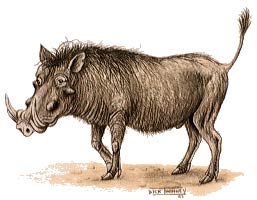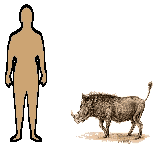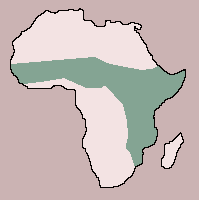Warthog

| Class: Mammalia:
Mammals |
Diet: Grass |
| Order:
Artiodactyla: Even-toed Ungulates |
| Size: body:1.1
- 1.4 m (3 1/2 - 4 1/2 ft), tail: 35 - 50 cm (13 3/4 - 19 3/4 in) |
| Family: Suidae: Pigs |
Conservation Status:
Non-threatened |
| Scientific Name:
Phacochoerus aethiopicus |
Habitat: savanna,
treeless open plains |
| Range:
Africa: Ghana to Somalia, south to South Africa: Natal |
 The
warthog has long legs, a large head and a broad muzzle that bears tusks
derived from the canine teeth. On each side of the big head are two wartlike
protuberances -- the origin of the animal's common name. Its bristly coat
is sparse, but there is a mane of long bristles running to the middle of
the back, and there are whiskers on the lower jaw. The female is smaller
than the male and has shorter tusks. Generally gregarious, warthogs live
in family groups in a territory that may be shared by more than one family.
They prefer to have water for drinking and wallowing within their range
and also some form of shelter, such as aardvark burrows or holes among
rocks, where they rest in the heat of the day and at night. The
warthog has long legs, a large head and a broad muzzle that bears tusks
derived from the canine teeth. On each side of the big head are two wartlike
protuberances -- the origin of the animal's common name. Its bristly coat
is sparse, but there is a mane of long bristles running to the middle of
the back, and there are whiskers on the lower jaw. The female is smaller
than the male and has shorter tusks. Generally gregarious, warthogs live
in family groups in a territory that may be shared by more than one family.
They prefer to have water for drinking and wallowing within their range
and also some form of shelter, such as aardvark burrows or holes among
rocks, where they rest in the heat of the day and at night.  As well as grazing on short grass, warthogs feed on fruit and, in dry spells,
will probe the ground with their tusks to obtain bulbs, tubers and roots.
They occasionally prey on small mammals and will take carrion. Timing of
the breeding season tends to be associated with the local rainy seasons.
The female gives birth to 2 to 4 young after a gestation of 170 to 175
days. The young suckle for up to 4 months but, after a week, start to leave
the burrow in which they are born to feed on grass.
As well as grazing on short grass, warthogs feed on fruit and, in dry spells,
will probe the ground with their tusks to obtain bulbs, tubers and roots.
They occasionally prey on small mammals and will take carrion. Timing of
the breeding season tends to be associated with the local rainy seasons.
The female gives birth to 2 to 4 young after a gestation of 170 to 175
days. The young suckle for up to 4 months but, after a week, start to leave
the burrow in which they are born to feed on grass.
 
|
